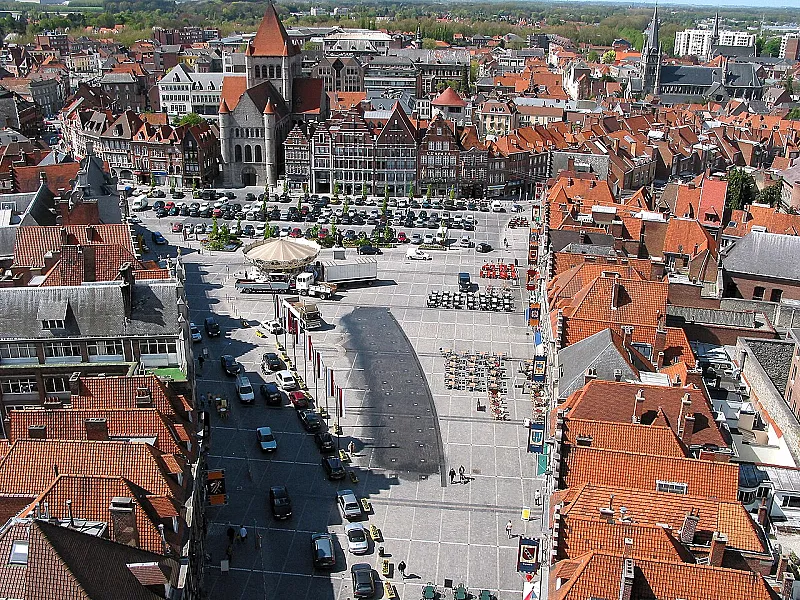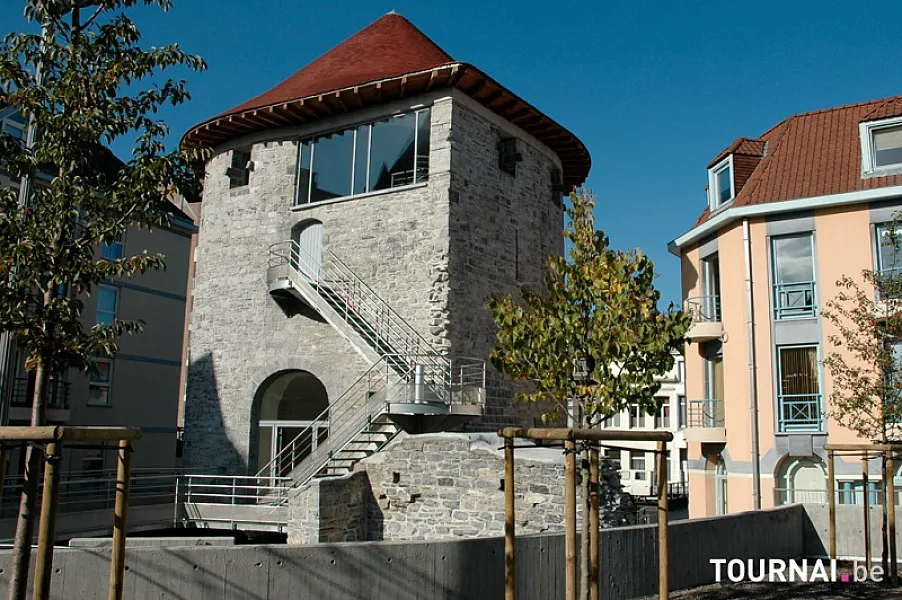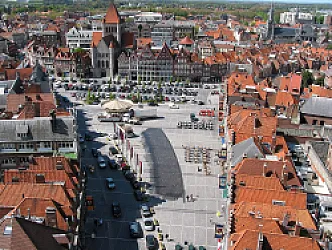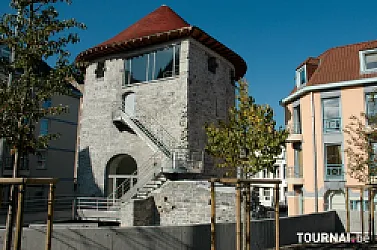Visitez Tournai en 2 jours
12 POIs incontournables, parcours optimisés et anecdotes.
Chargement de la carte...
Vous allez visiter les plus beaux points d'intérêt de Tournai
2 Days in Tournai — A Compact Love Letter to Belgium's Quiet Giant
Tournai stole my heart the moment I stepped onto its cobbled streets. The city feels like a secret passed between friends, full of layered history and the hush of church bells. Locals sometimes call it the "City of Five Bell Towers," and that sound still rings in my memory. Some people say it is overrated, but for me the intimacy and slow rhythms are the magic. I wandered here alone one rainy afternoon and left planning my return.
Why visit Tournai? Because it is more than a postcard. The city blends solemn medieval stone with warm cafés and surprising contemporary museums. You can stand beneath the soaring vaults of Notre-Dame Cathedral of Tournai and feel tiny, then stroll to the lively Grand-Place where local chatter mixes with the scent of fresh fries. Maison Tournaisienne reveals private lives from centuries past. Queen Astrid Park offers green calm and a view of the river. Expect soft bell tones, toasted bread aromas, and the rough feel of old bricks beneath your fingers. This is a place to look, listen, and slow down.
Planning can feel overwhelming. There is so much to see you could easily spend weeks exploring. If you are short on time, I get the frustration; I’ve rushed through cities before and regretted it. That’s why this compact plan exists. Below, I’ll show you exactly how to spend 2 days in Tournai without missing the soul of the place. It’s designed for first time in Tournai visitors who want a true taste of the city, not a checklist of sights.
Key tip: Arrive early to the cathedral and Grand-Place. Morning light makes the stone glow and the streets stay quiet. You’ll photograph better, hear the bells clearly, and enjoy a peaceful moment before tour groups arrive. This simple trick changes everything. Now let’s dive into the Tournai itinerary and discover what to see in Tournai over a perfect weekend.

Quick Mini Guide to Tournai
Where to stay:
- Choose the Old Town near Grand-Place for walking access to the Cathedral, City Hall and cafés.
- Riverside hotels by the Scheldt offer quieter evenings and scenic morning walks.
When to visit:
- Spring and early autumn — mild weather for climbing the cathedral towers and strolling Queen Astrid Park.
- Weekdays or early mornings to avoid coach-group peaks at Notre‑Dame Cathedral and the Belfry.
Things to do (2 days):
- Day 1: Notre‑Dame Cathedral of Tournai (note the five towers and UNESCO site), then Maison Tournaisienne for local interiors and history.
- Day 2: Tournai City Hall and Belfry on the Grand‑Place, relax in Queen Astrid Park; finish with a riverside café on the Scheldt.
- Try one interactive tour — The Alchemist TOURNAI or The Trophy of the Tribes TOURNAI — gamified walking routes (book ahead, ~1–2 hours).
Don't forget:
- Comfortable shoes for cobbled streets and narrow alleys.
- Check opening hours for Maison Tournaisienne and climb times for the Belfry; small museums close midday in low season.
Jour 1 - Tournai
6 POIs à découvrirJour 1 - Matin à Tournai
5 Points d'intérêt - Durée : 4h15 - Distance : 1 km - Marche : 0h13
Maison Tournaisienne
- Le Musée de Folklore et des Imaginaires, anciennement la Maison tournaisienne, est situé dans une bâtisse du XVIIe siècle depuis 1930. Le musée reconstitue des scènes de la vie quotidienne en ville et à la campagne, mettant en avant le folklore et l'ambiance d'époques passées. Les visiteurs peuvent découvrir des artisans en plein travail, des chœurs de chapelle, des déguisements de carnaval et même un cabaret dans les différentes salles du musée. Les expositions comprennent des vitrines présentant des objets traditionnels révélateurs des us et coutumes des siècles précédents, couvrant plus de 1000 m².

Hôtel de ville de Tournai
- L'Hôtel de ville de Tournai est situé dans un parc agréable.
- Il occupe une partie de l'ancienne abbaye bénédictine Saint-Martin.
- Construit au XIe siècle, le monastère fut supprimé en 1797.
- Reconstruit en 1763 sous l'abbatiat de Robert Delzenne.
- Un incendie a ravagé l'intérieur de l'édifice en 1940, mais les façades néoclassiques ont survécu.
- De l'ancienne abbaye, subsistent une crypte romane impressionnante et une partie du cloître gothique.

Cathédrale Notre-Dame de Tournai
- La Cathédrale Notre-Dame de Tournai est est le seul édifice religieux de Belgique construit spécifiquement comme cathédrale.
- La construction de la cathédrale a débuté au XIIe siècle, avec un style gothique scaldien, alliant harmonieusement les styles roman et gothique. Trois cathédrales se sont succédé sur le site depuis le Ve siècle, avec des restaurations et des ajouts successifs.
- Elle présente des dimensions impressionnantes, avec une longueur totale de 134 mètres et cinq tours romanes d'une hauteur de 83 mètres.
- Les cinq tours romanes surplombent la cathédrale, annonçant déjà l'art gothique.
- La nef romane, la partie la plus ancienne, est caractérisée par son décor sculpté riche et ses proportions harmonieuses.
- Le transept, bien que moins harmonieux que la nef, impressionne par ses proportions, et le chœur gothique est gigantesque, avec une longueur totale de 58 mètres.
- La cathédrale présente un riche décor sculpté et des éléments architecturaux remarquables, témoignant de son importance historique et artistique.

Grand-Place
- La Grand-Place de Tournai est le centre d'activité de la ville belge, avec une forme triangulaire résultant de voies antiques.
- À l'origine un cimetière, elle devient une place de marché lors de l'époque carolingienne, marquant le centre de la vie communale après l'érection d'un beffroi en 1187.
- Détruite en grande partie par les bombardements allemands en 1940, la Grand-Place est reconstruite en conservant des éléments historiques.
- La Halle aux draps, construite au XIIe siècle, est un bâtiment emblématique où se tenaient les marchés de tissus et de draps.
- Une statue de bronze de la princesse d'Epinoy, Christine de Lalaing, trône au centre de la Grand-Place, honorant sa prétendue défense de la ville lors du siège de 1581.
- La Grand-Place reste un lieu animé pour les échanges commerciaux, les foires et les événements, avec une ambiance restauratrice variée et typique de la région.

Fort Rouge
- Le Fort Rouge était une tour d'angle défensive de la première enceinte communale, mais des découvertes suggèrent des réaménagements ultérieurs.
- Philippe II Auguste a impulsé la construction du Fort Rouge à la fin du 12e siècle.
- Des fouilles archéologiques ont révélé des structures plus anciennes, confirmant l'intégration du Fort Rouge dans la première enceinte communale.
- Après des années d'oubli, la Ville de Tournai a entrepris la restauration du Fort Rouge et de ses environs.
- Il abrite désormais des expositions temporaires sur ses deux niveaux restaurés Le site rénové, désormais appelé ''îlot des XII Césars'', comprend le Fort Rouge et des espaces verts ouverts au public.
Jour 1 - Après-midi à Tournai
1 Points d'intérêt - Durée : 0h45 - Distance : 0 km - Marche : 0h00Parc Reine Astrid
- Le square de la Reine est créé en 1872 sur l'emplacement des ouvrages fortifiés de l'Ancien Régime.
- Il remplace les remparts, fossés et bastions qui défendaient la porte des "Sept Fontaines".
- Le parc comprend principalement un plan d'eau, proche du niveau de l'Escaut.
- On peut y trouver un noyer noir, le plus gros du pays, ainsi que des cyprès chauves et des hêtres pourpres parmi d'autres variétés d'arbes.
- Concernant les fleurs, des mahonias, hortensias et hibiscus ont été plantés, répondant aux souhaits des habitants de Tournai. Il y a aussi une partie du cadran solaire de l'artiste Richard Owczarek, de 80 cm de largeur et plus d'un mètre de longueur.
- Ce cadran est particulier: Sa table forme un angle de 50 degrés avec le plan horizontal, équivalent à un cadran horizontal à l'équateur.
- Les lignes horaires sont parallèles en conséquence.
- Le style, malheureusement enlevé, était également parallèle à la table du cadran.⏰ Il est conçu pour indiquer l'heure solaire de 7 h à 17 h.
Jour 2 - Tournai
6 POIs à découvrirJour 2 - Matin à Tournai
5 Points d'intérêt - Durée : 4h15 - Distance : 1 km - Marche : 0h13
Maison Tournaisienne
- Le Musée de Folklore et des Imaginaires, anciennement la Maison tournaisienne, est situé dans une bâtisse du XVIIe siècle depuis 1930. Le musée reconstitue des scènes de la vie quotidienne en ville et à la campagne, mettant en avant le folklore et l'ambiance d'époques passées. Les visiteurs peuvent découvrir des artisans en plein travail, des chœurs de chapelle, des déguisements de carnaval et même un cabaret dans les différentes salles du musée. Les expositions comprennent des vitrines présentant des objets traditionnels révélateurs des us et coutumes des siècles précédents, couvrant plus de 1000 m².

Hôtel de ville de Tournai
- L'Hôtel de ville de Tournai est situé dans un parc agréable.
- Il occupe une partie de l'ancienne abbaye bénédictine Saint-Martin.
- Construit au XIe siècle, le monastère fut supprimé en 1797.
- Reconstruit en 1763 sous l'abbatiat de Robert Delzenne.
- Un incendie a ravagé l'intérieur de l'édifice en 1940, mais les façades néoclassiques ont survécu.
- De l'ancienne abbaye, subsistent une crypte romane impressionnante et une partie du cloître gothique.

Cathédrale Notre-Dame de Tournai
- La Cathédrale Notre-Dame de Tournai est est le seul édifice religieux de Belgique construit spécifiquement comme cathédrale.
- La construction de la cathédrale a débuté au XIIe siècle, avec un style gothique scaldien, alliant harmonieusement les styles roman et gothique. Trois cathédrales se sont succédé sur le site depuis le Ve siècle, avec des restaurations et des ajouts successifs.
- Elle présente des dimensions impressionnantes, avec une longueur totale de 134 mètres et cinq tours romanes d'une hauteur de 83 mètres.
- Les cinq tours romanes surplombent la cathédrale, annonçant déjà l'art gothique.
- La nef romane, la partie la plus ancienne, est caractérisée par son décor sculpté riche et ses proportions harmonieuses.
- Le transept, bien que moins harmonieux que la nef, impressionne par ses proportions, et le chœur gothique est gigantesque, avec une longueur totale de 58 mètres.
- La cathédrale présente un riche décor sculpté et des éléments architecturaux remarquables, témoignant de son importance historique et artistique.

Grand-Place
- La Grand-Place de Tournai est le centre d'activité de la ville belge, avec une forme triangulaire résultant de voies antiques.
- À l'origine un cimetière, elle devient une place de marché lors de l'époque carolingienne, marquant le centre de la vie communale après l'érection d'un beffroi en 1187.
- Détruite en grande partie par les bombardements allemands en 1940, la Grand-Place est reconstruite en conservant des éléments historiques.
- La Halle aux draps, construite au XIIe siècle, est un bâtiment emblématique où se tenaient les marchés de tissus et de draps.
- Une statue de bronze de la princesse d'Epinoy, Christine de Lalaing, trône au centre de la Grand-Place, honorant sa prétendue défense de la ville lors du siège de 1581.
- La Grand-Place reste un lieu animé pour les échanges commerciaux, les foires et les événements, avec une ambiance restauratrice variée et typique de la région.

Fort Rouge
- Le Fort Rouge était une tour d'angle défensive de la première enceinte communale, mais des découvertes suggèrent des réaménagements ultérieurs.
- Philippe II Auguste a impulsé la construction du Fort Rouge à la fin du 12e siècle.
- Des fouilles archéologiques ont révélé des structures plus anciennes, confirmant l'intégration du Fort Rouge dans la première enceinte communale.
- Après des années d'oubli, la Ville de Tournai a entrepris la restauration du Fort Rouge et de ses environs.
- Il abrite désormais des expositions temporaires sur ses deux niveaux restaurés Le site rénové, désormais appelé ''îlot des XII Césars'', comprend le Fort Rouge et des espaces verts ouverts au public.
Jour 2 - Après-midi à Tournai
1 Points d'intérêt - Durée : 0h45 - Distance : 0 km - Marche : 0h00Parc Reine Astrid
- Le square de la Reine est créé en 1872 sur l'emplacement des ouvrages fortifiés de l'Ancien Régime.
- Il remplace les remparts, fossés et bastions qui défendaient la porte des "Sept Fontaines".
- Le parc comprend principalement un plan d'eau, proche du niveau de l'Escaut.
- On peut y trouver un noyer noir, le plus gros du pays, ainsi que des cyprès chauves et des hêtres pourpres parmi d'autres variétés d'arbes.
- Concernant les fleurs, des mahonias, hortensias et hibiscus ont été plantés, répondant aux souhaits des habitants de Tournai. Il y a aussi une partie du cadran solaire de l'artiste Richard Owczarek, de 80 cm de largeur et plus d'un mètre de longueur.
- Ce cadran est particulier: Sa table forme un angle de 50 degrés avec le plan horizontal, équivalent à un cadran horizontal à l'équateur.
- Les lignes horaires sont parallèles en conséquence.
- Le style, malheureusement enlevé, était également parallèle à la table du cadran.⏰ Il est conçu pour indiquer l'heure solaire de 7 h à 17 h.
Where to Stay in Tournai
For a short, relaxed two-day visit to Tournai, location matters more than flashy facilities. The city is compact and largely built around its medieval heart, so choosing a base close to the sights saves time and reduces stress. Staying near the historic center means you can pop back to your room between museum visits, linger over a long lunch without rushing, and enjoy the atmosphere of the old streets after the daytime crowds have thinned.
Tournai is organized around a few easy-to-understand anchors: the elevated cathedral precinct around the Notre-Dame, the lively market area where the Grand-Place and Tournai City Hall sit, the intimate lanes that host the Maison Tournaisienne, and the greener belt toward Queen Astrid Park and the train approaches. The river adds a pleasant edge to walks but all the main attractions are within a short stroll of one another, which makes the city ideal for exploring on foot.
If you want to be in the thick of it, pick accommodation within a few minutes’ walk of the Cathedral or the Grand-Place: you’ll be able to visit Notre-Dame Cathedral of Tournai early in the morning or late in the day when light and quiet are at their best, and the museum circuit (including Maison Tournaisienne) is just around the corner. For a quieter stay with easy rail links, consider the area toward Queen Astrid Park and the train station, where green space and convenience meet — still close enough to return for a short rest between activities.
Practical transport tips: most visitors find everything reachable on foot — many of the attractions are within comfortable walking distance of each other — but Tournai also has a simple local bus network and regular regional trains to Brussels and Lille if you’re planning day trips. If you’re arriving by car, expect limited central parking; choosing a place near public transport or a hotel that offers a parking option can remove that hassle.
Finally, choose accommodation that matches how you like to travel: a cosy B&B or an apartment gives you flexibility and local charm, while smaller hotels often help with luggage and local tips. In historic buildings, check for practical features like lift access and a quiet room facing a courtyard. Book a little ahead for weekends or event dates, and otherwise relax — with a central, well-located base you’ll cover Tournai’s highlights easily and enjoy a calm, memorable stay.
Getting Around Tournai
Tournai is wonderfully compact, and public transport here feels friendly rather than intimidating — perfect for first-time visitors. The town center, with the Grand-Place, Notre-Dame Cathedral and the belfry within easy reach, is a pleasure to explore on foot, but when you need to stretch farther you'll find a simple network of regional trains and local buses. The main operators are SNCB for trains and TEC for buses, and both serve clear stops around the city, so you never feel lost even if this is your first trip. I love how the city blends walking routes with short, reliable rides — it makes sightseeing relaxed and efficient 🚇.
A practical tip about fares: you can usually buy single tickets from a ticket machine at the station, from drivers on buses (exact change sometimes required), or via the official apps for SNCB and TEC. If you plan a few journeys in a day, consider a day pass or a short-term regional pass — they simplify hopping on and off without thinking about every fare. For repeat visitors or longer stays, a reloadable card is handy; otherwise the apps and machines cover most needs easily 🎫.
Use Google Maps for real-time directions and to compare walking versus bus or train times. I rely on it to tell me whether it’s a pleasant 12-minute stroll between sights or better to catch the next bus. Maps will also show which bus stop to use and estimated arrivals, and when combined with the SNCB app for trains you can see platform information in advance. Downloading offline maps for a day or two gives extra peace of mind if your data is patchy.
If you want to save money, prioritise walking for short hops — many of Tournai’s highlights are clustered and strolling lets you discover hidden streets and cafés. Buy round-trip train tickets or multi-ride bus passes when available, and check for any regional discounts (student, senior, or group rates). Timing off-peak travel can also lower costs and keep crowded buses at bay; small changes in timing add up to big comfort and savings over a few days 💡.
I remember arriving at Tournai station with a suitcase and debating a bus versus a walk. We took a short TEC ride to the heart of town, then left our bags at the guesthouse and walked from the Maison Tournaisienne straight to the cathedral. It was only a ten-minute stroll to the Notre-Dame Cathedral, and that mix — one short bus, then walking between the sights — became our rhythm for the weekend. Once you try it, you’ll see how easy and charming getting around Tournai can be 🗺️.
What to Pack for Tournai
Tournai is delightfully compact but rich — cathedral spires, small museums, cobbled streets and quiet squares where you’ll linger longer than you planned. I’ve done weekend trips where I covered the town on foot for 9–10 hours a day and another when I relaxed with just a few short strolls; packing light but smart makes both days enjoyable. Below are the essentials I actually use and why each one mattered on my trips.
1. Comfortable walking shoes (e.g., Merrell Moab 2 or Ecco Soft 7): I once walked roughly 8 miles in a day around the cathedral, the belfry and across the old town — my feet would have been ruined without supportive shoes. Choose shoes with good arches and a grippy sole for cobbles; you’ll thank yourself after staircases and uneven pavements.
2. Cross-body bag (zippered, anti-theft): I prefer a small cross-body with an internal zip pocket — I wore mine while exploring the cathedral and market and felt secure when the streets got crowded. Tournai is generally safe, but tourist areas attract pickpockets; a bag you can keep in front is both comfortable and practical for a day out.
3. Weather-appropriate clothing (layers + lightweight rain jacket): Belgian weather flips quickly. On one trip I started with a T-shirt and ended the day in a waterproof layer after a sudden shower. Pack a thin fleece or sweater and a packable rain jacket — layers let you adapt when it’s cool in the morning, mild by midday and damp later.
4. Power adapter (Type E/European plug) and phone charger: Belgium uses Type E (230V). I forgot my adapter once and borrowed one from my B&B host — a hassle I won’t repeat. A small EU adapter lets you charge your phone and camera in the hotel and keeps you ready for maps and photos.
5. Power bank (10,000 mAh recommended): I was out for 10+ hours taking photos of the cathedral and using maps; my phone hit 15% by late afternoon until I used a 10,000 mAh power bank to get through the evening. Compact but powerful keeps navigation and ticket apps alive.
6. Optional: compact umbrella + reusable water bottle: On rainy days a tiny umbrella saved me from soggy maps; on sunny strolls a refillable bottle saved money and kept me refreshed while wandering between sites. Both are small, low-weight additions that paid off when I needed them.
Enjoy Your Trip to Tournai!
Two days in Tournai, packed with six must-see spots, give you a perfect snapshot of the city. From the charming Maison Tournaisienne to the ornate Tournai City Hall and the towering Notre-Dame Cathedral of Tournai, this itinerary moves through museums, historic fortifications and cultural landmarks — everything you need for a lively, well-rounded weekend.
Remember, this guide is a map, not a strict timetable: leave room for the unexpected. The real magic often happens in unplanned moments — getting delightfully lost in narrow streets, stumbling on small museums or a hidden chapel, or lingering for a spontaneous café stop. Allow extra time for a local market, a photo break, or a friendly chat with a shopkeeper. Don’t pressure yourself to see EVERYTHING; savor the pace and the surprises.
I hope you fall for Tournai’s warm corners and layered history. I’m excited for you to wander through the Maison Tournaisienne, stand before the cathedral’s stained glass, and make unforgettable memories. Embrace curiosity, follow what delights you, and let the city surprise you.
Want to explore in a playful way? Check out Coddy’s gamified tours — The Alchemist TOURNAI and The Trophy of the Tribes TOURNAI — for interactive challenges that turn your city walk into a small adventure. They’re fun and simple to follow.
Enjoy! Safe travels! Have fun! If you want, share your discoveries or ask a question — I’d love to hear about your Tournai stories.
Envie de plus d'aventure ?
Découvrez nos jeux d'évasion urbains pour transformer votre visite en aventure interactive !
















